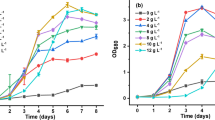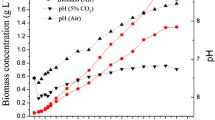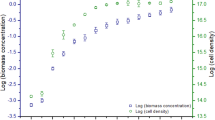Abstract
The relation between fatty acid accumulation, activity of acetyl-CoA carboxylase (ACC), and consequently lipid accumulation was studied in the microalgae Chlorella vulgaris co-immobilized with the plant growth-promoting bacterium Azospirillum brasilense under dark heterotrophic conditions with Na acetate as a carbon source. In C. vulgaris immobilized alone, cultivation experiments for 6 days showed that ACC activity is directly related to fatty acid accumulation, especially in the last 3 days. In co-immobilization experiments, A. brasilense exerted a significant positive effect over ACC activity, increased the quantity in all nine main fatty acids, increased total lipid accumulation in C. vulgaris, and mitigated negative effects of nonoptimal temperature for growth. No correlation between ACC activity and lipid accumulation in the cells was established for three different temperatures. This study demonstrated that the interaction between A. brasilense and C. vulgaris has a significant effect on fatty acid and lipid accumulation in the microalgae.


Similar content being viewed by others
References
Alban C, Baldet P, Douce R (1994) Localization and characterization of two structurally different forms of acetyl-CoA carboxylase in young pea leaves, of which one is sensitive to aryloxyphenoxypropionate herbicides. Biochem J 300:557–565
Bashan Y (1986) Alginate beads as synthetic inoculant carriers for the slow release of bacteria that affect plant growth. Appl Environ Microbiol 51:1089–1098
Bashan Y, de-Bashan LE (2010) How the plant growth-promoting bacterium Azospirillum promotes plant growth—a critical assessment. Adv Agron 108:77–136
Bashan Y, Hernandez JP, Leyva LA, Bacilio M (2002) Alginate microbeads as inoculant carrier for plant growth-promoting bacteria. Biol Fertil Soils 35:359–368
Bashan Y, de-Bashan LE, Prabhu SR, Hernandez J-P (2014) Advances in plant growth-promoting bacterial inoculant technology: formulations and practical perspectives (1998–2013). Plant Soil 378:1–33
Bigogno C, Khozin-Golberg I, Adlerstein D, Cohen Z (2002) Biosynthesis of arachidonic acid in the oleaginous microalga Parietochloris incise (Chloroficeae): radiolabeling studies. Lipids 37:1–8
Bligh GE, Dyer JW (1959) A rapid method f total lipid extraction and purification. Can J Biochem Physiol 37:911–917
Brennan L, Owende P (2010) Biofuels from microalgae—a review of technologies for production, processing, and extractions of biofuels and co-products. Renew Sust Energ Rev 14:557–567
Bumbak F, Cook S, Zachleder V, Hauser S, Kovar K (2011) Best practices in heterotrophic high-cell-density microalgal processes: achievements, potential and possible limitations. Appl Microbiol Biotechnol 91:31–46
Chisti Y (2007) Biodiesel from microalgae. Biotechnol Adv 25:294–306
Choix FJ, de-Bashan LE, Bashan Y (2012a) Enhanced accumulation of starch and total carbohydrates in alginate-immobilized Chlorella spp. induced by Azospirillum brasilense. I. Autotrophic conditions. Enzym Microb Technol 51:294–299
Choix FJ, de-Bashan LE, Bashan Y (2012b) Enhanced accumulation of starch and total carbohydrates in alginate-immobilized Chlorella spp. induced by Azospirillum brasilense. II. Heterotrophic conditions. Enzym Microb Technol 51:300–309
Choix FJ, Bashan Y, Mendoza A, de-Bashan LE (2014) Enhanced activity of ADP glucose pyrophosphorylase and formation of starch induced by Azospirillum brasilense in Chlorella vulgaris. J Biotechnol 177:22–34
Covarrubias SA, de-Bashan LE, Moreno M, Bashan Y (2012) Alginate beads provide a beneficial physical barrier against native microorganisms in wastewater treated with immobilized bacteria and microalgae. Appl Microbiol Biotechnol 93:2669–2680
Cruz I, Bashan Y, Hernández-Carmona G, de-Bashan LE (2013) Biological deterioration of alginate beads containing immobilized microalgae and bacteria during tertiary wastewater treatment. Appl Microbiol Biotechnol 97:9847–9858
de-Bashan LE, Bashan Y (2008) Joint immobilization of plant growth-promoting bacteria and green microalgae in alginate beads as an experimental model for studying plant-bacterium interactions. Appl Environ Microbiol 74:6797–6802
de-Bashan LE, Bashan Y (2010) Immobilized microalgae for removing pollutants: review of practical aspects. Bioresource Technol 101:1611–1627
de-Bashan LE, Bashan Y, Moreno M, Lebsky VK, Bustillos JJ (2002) Increased pigment and lipid content, lipid variety, and cell and population size of the microalgae Chlorella spp. when coimmobilized in alginate beads with the microalgae-growth-promoting bacteria Azospirillum brasilense. Can J Microbiol 48:514–521
de-Bashan LE, Hernandez JP, Morey T, Bashan Y (2004) Microalgae growth-promoting bacteria as helpers for microalgae: a novel approach for removing ammonium and phosphorus from municipal wastewater. Water Res 38:466–474
de-Bashan LE, Antoun H, Bashan Y (2005) Cultivation factors and population size control uptake of nitrogen by the microalgae Chlorella vulgaris when interacting with the microalgae growth-promoting bacterium Azospirillum brasilense. FEMS Microbiol Ecol 54:197–203
de-Bashan LE, Antoun H, Bashan Y (2008a) Involvement of indole-3-acetic-acid produced by the growth-promoting bacterium Azospirillum spp. in promoting growth of Chlorella vulgaris. J Phycol 44:938–947
de-Bashan LE, Magallon P, Antoun H, Bashan Y (2008b) Role of glutamate dehydrogenase and glutamine synthetase in Chlorella vulgaris during assimilation of ammonium when jointly immobilized with the microalgae-growth-promoting bacterium Azospirillum brasilense. J Phycol 44:1188–1196
de-Bashan LE, Schmid M, Rothballer M, Hartmann A, Bashan Y (2011) Cell-cell interaction in the eukaryote-prokaryote model using the microalgae Chlorella vulgaris and the bacterium Azospirillum brasilense immobilized in polymer beads. J Phycol 47:1350–1359
Dunahay TG, Jarvis EE, Dais SS, Roessler PG (1996) Manipulation of microalgal lipid production using genetic engineering. Appl Biochem Biotechnol 57(58):223–231
Egli MA, Gengenbach BG, Gronwald JW, Somers DA, Wyse DL (1993) Characterization of maize acetyl-coenzyme A carboxylase. Plant Physiol 101:499–506
Gonzalez LE, Bashan Y (2000) Growth promotion of the microalga Chlorella vulgaris when coimmobilized and cocultured in alginate beads with the plant-growth-promoting bacterium Azospirillum brasilense. Appl Environ Microbiol 66:1527–1531
Gonzalez LE, Cañizares RO, Baena S (1997) Efficiency of ammonia and phosphorus removal from a Colombian agroindustrial wastewater by the microalgae Chlorella vulgaris and Scenedesmus dimorphus. Bioresour Technol 60:259–262
Hayashi O, Satoh K (2006) Determination of acetyl-CoA and malonyl-CoA in germinating rice seeds using the LC-MS/MS technique. Biosci Biotechnol Biochem 70:2676–2681
Herbert D, Price L, Alban C, Dehaye L, Job D, Cole D, Pallet K, Hardwood J (1996) Kinetic studies on two isoforms of acetyl-CoA carboxylase from maize leaves. Biochem J 318:997–1006
Hernandez J-P, de-Bashan LE, Bashan Y (2006) Starvation enhances phosphorus removal from wastewater by the microalga Chlorella spp. co-immobilized with Azospirillum brasilense. Enzym Microb Technol 38:190–198
Hu Q, Sommerfeld M, Jarvis E, Ghirardi M, Posewitz M, Seibert M, Darzins A (2008) Microalgal triacylglycerols as feedstocks for biofuels production: perspectives and advances. Plant J 54:621–639
Ilangovan K, Cañizares-Villanueva RO, González Moreno S, Voltolina D (1998) Effect of cadmium and zinc on respiration and photosynthesis in suspended and immobilized cultures of Chlorella vulgaris and Scenedesmus acutus. Bull Environ Contam Toxicol 60:936–943
Isleten-Hosoglu M, Gulpete I, Elibol M (2012) Optimization of carbon and nitrogen sources for biomass and lipid production by Chlorella saccharophila under heterotrophic conditions and development of Nile red fluorescence based method for quantification of its neutral lipid content. Biochem Eng J 61:11–19
James ES, Cronan JE (2004) Expression of two Escherichia coli acetyl-CoA carboxylase subunits is autoregulated. J Biol Chem 279:2520–2527
Khozin I, Adlerstein D, Bigongo C, Heimer YM, Cohen Z (1997) Elucidation of the biosynthesis of eicosapentaenoic acid in the microalga Porphyridium cruentum. Plant Physiol 114:223–230
Khozin-Goldberg I, Cohen Z (2011) Unraveling algal lipid metabolism: recent advances in gene identification. Biochimie 93:91–100
Klaus D, Ohlrogge J, Ekkerhard Neuhaus H, Dörmann P (2004) Increased fatty acid production in potato by engineering of Acetyl-CoA carboxylase. Planta 219:389–396
Lebeau T, Robert JM (2006) Biotechnology of immobilized micro algae: a culture technique for the future? In: Rao S (ed) Algal cultures, analogues of blooms and applications. Science Publishers, Enfield, pp 801–837
Levert KL, Waldrop GL, Stephens JM (2002) A biotin analogue inhibits acetyl CoA carboxylase activity and adipogenesis. J Biol Chem 277:16347–16350
Leyva LA, Bashan Y, de-Bashan LE (2014) Activity of acetyl-CoA carboxylase is not directly linked to accumulation of lipids when Chlorella vulgaris is co-immobilised with Azospirillum brasilense in alginate under autotrophic and heterotrophic conditions. Ann Microbiol. doi:10.1007/s13213-014-0866
Liu W, Harrison DK, Chalupska D, Gornicki P, O’Donnell C, Adkins S, Haselkorn R, Williams R (2007) Single-site mutations in the carboxyltransferase domain of plastid acetyl-CoA carboxylase confer resistance to grass-specific herbicides. PNAS USA 104:3627–3632
Liu J, Huang J, Sun Z, Zhong Y, Jiang Y, Chen F (2011) Differential lipid and fatty acid profiles of photoautotrophic and heterotrophic Chlorella zofingiensis: assessment of algal oils for biodiesel production. Bioresour Technol 102:106–110
Livne A, Sukenik A (1992) Lipid synthesis and abundance of acetyl-CoA carboxylase in Isochrysis galbana (Prymnesiophyceae) following nitrogen starvation. Plant Cell Physiol 33:1175–1181
Mata TM, Martins AA, Caetano NS (2010) Microalgae for biodiesel production and other applications: a review. Renew Sust Energ Rev 14:217–232
O’Grady J, Morgan A (2011) Heterotrophic growth and lipid production of Chlorella protothecoides on glycerol. Bioprocess Eng 34:121–125
Oh-Hama T, Miyachi S (1992) Chlorella. In: Borowitzka MA, Borowitzka LJ (eds) Micro-algae biotechnology. Cambridge University Press, Cambridge, pp 3–26
Ötles S, Pire R (2001) Fatty acid composition of Chlorella and Spirulina microalgae species. J AOAC Int 84:1708–1714
Pande SV, Parvin RK, Venkitasubramanian TA (1963) Microdetermination of lipids and serum total fatty acids. Anal Biochem 6:415–423
Perez-Garcia O, de-Bashan LE, Hernandez J-P, Bashan Y (2010) Efficiency of growth and nutrient uptake from wastewater by heterotrophic, autotrophic, and mixotrophic cultivation of Chlorella vulgaris immobilized with Azospirillum brasilense. J Phycol 46:800–812
Perez-Garcia O, Bashan Y, Puente ME (2011a) Organic carbon supplementation of sterilized municipal wastewater is essential for heterotrophic growth and removing ammonium by the microalga Chlorella vulgaris. J Phycol 47:190–199
Perez-Garcia O, Escalante FME, de-Bashan LE, Bashan Y (2011b) Heterotrophic cultures of microalgae: metabolism and potential products. Water Res 45:11–36
Petkov G, Garcia G (2007) Which are fatty acids of the green alga Chlorella? Biochem Syst Ecol 35:281–285
Prasad K, Kadokawa JI (2009) Alginate-based blends and nano/microbeads. Microbiol Monogr 13:175–210
Přibyl P, Cepák V, Zachleder V (2012) Production of lipids in 10 strains of Chlorella and Parachlorella, and enhanced lipid productivity in Chlorella vulgaris. Appl Microbiol Biotechnol 94:549–561
Radakovits R, Jinkerson RE, Darzins A, Pasewitz C (2010) Genetic engineering of algae for enhanced biofuel production. Eukaryot Cell 9:486–501
Ratledge C (2004) Fatty acid biosynthesis in microorganisms being used for single cell oil production. Biochimie 86:807–815
Rawat I, Ranjith Kumar R, Mutanda T, Bux F (2013) Biodiesel from microalgae: a critical evaluation from laboratory to large scale production. Appl Energy 103:444–467
Rodolfi L, Chini Zittelli G, Bassi N, Padovani G, Biondi N, Bonini G, Tredici MR (2009) Microalgae for oil: strain selection, induction of lipid synthesis and outdoor mass cultivation in a low-cost photobioreactor. Biotechnol Bioeng 102:100–112
Roessler PG, Ohlrogge JB (1993) Cloning and characterization of the gene that encodes acetyl-coenzyme A carboxylase in the alga Cyclotella cryptica. J Biol Chem 268:19254–19259
Sasaki Y, Nagano Y (2004) Plant acetyl-CoA carboxylase: structure, biosynthesis, regulation and gene manipulation for plant breeding. Biosci Biotechnol Biochem 68:1175–1184
Sato N, Moriyama T (2007) Genomic and biochemical analysis of lipid biosynthesis in the unicellular rhodophyte Cyanidioschyzon merolae: lack of plastidic desaturation pathway results in the coupled pathway of galactolipid synthesis. Eukaryot Cell 6:1006–1017
Sato N, Murata N (1988) Membrane lipids. Methods Enzymol 167:251–259
Sheehan J, Dunahay T, Benemann J, Roessler PG (1998) US Department of Energy’s Office of Fuels Development. A look back at the US Department of Energy’s Aquatic Species Program—biodiesel from algae, close out report TP-580-24190. Golden, CO: National Renewable Energy Laboratory
Sukenik A, Livne A (1991) Variations in lipid and fatty acid content in relation to acetyl CoA carboxylase in the marine Prymnesiophyte Isochrysis galbana. Plant Cell Physiol 32:371–378
Tal S, Okon Y (1985) Production of the reserve material poly-β-hydroxybutyrate and its function in Azospirillum brasilense Cd. Can J Microbiol 31:608–613
Tang D, Han W, Li P, Miao X, Zhong J (2011a) CO2 biofixation and fatty acid composition of Scenedesmus obliquus and Chlorella pyrenoidosa in response to CO2 levels. Bioresour Technol 102:3071–3076
Tang H, Chen M, Garcia MED, Abunasser N, Simon Ng KY, Salley SO (2011b) Culture of microalgae Chlorella minutissima for biodiesel feedstock production. Biotechnol Bioeng 108:2280–2287
Tong L, Hardwood HJ (2006) Acetyl-coenzyme A carboxylases: versatile targets for drug discovery. J Cell Biochem 99:1476–1488
Wan M, Wang R, Xia J, Rosenberg J, Nie Z, Kobayashi N, Oyler G, Betenbaugh M (2012) Physiological evaluation of a new Chlorella sorokiniana isolate for its biomass production and lipid accumulation in photoautotrophic and heterotrophic cultures. Biotechnol Bioeng 109:1958–1964
Wu Z, Shi X (2007) Optimization for high-density cultivation of heterotrophic Chlorella based on a hybrid neural network model. Lett Appl Microbiol 44:13–18
Xiong W, Li X, Xiang J, Wu Q (2008) High-density fermentation of microalga Chlorella protothecoides in bioreactor for microbio-diesel production. Appl Microbiol Biotechnol 78:29–36
Xiong W, Gao CF, Yan D, Wu C, Wu QY (2010) Double CO2 fixation in photosynthesis-fermentation model enhances algal lipid synthesis for biodiesel production. Bioresour Technol 101:2287–2293
Yu Q, Collavo A, Zheng M, Owen M, Sattin M, Powles S (2007) Diversity of acetyl-coenzyme A carboxylase mutations in resistant Lolium populations: evaluation using clethodim. Plant Physiol 145:547–558
Acknowledgments
At CIBNOR, we thank Manuel Moreno for general technical support, Ira Fogel for English editing and editorial services, Fernando Garcia-Carreño for use of the HPLC, and Laura Carreon, Maria de los Angeles Navarrete del Toro, and Orlando Lugo for technical assistance. This study was supported by Consejo Nacional de Ciencia y Tecnologia of Mexico (CONACYT-Basic Science-2009, contracts 130656 and 164548). Time for writing was provided by The Bashan Foundation, USA. L.A.L. is a recipient of a graduate fellowship (CONACYT #48487) and periodic grants from The Bashan Foundation.
Author information
Authors and Affiliations
Corresponding author
Additional information
Dedication: This study is dedicated to the memory of the German/Spanish mycorrhizae researcher Dr. Horst Vierheilig (1964–2011) of CSIC, Spain
Rights and permissions
About this article
Cite this article
Leyva, L.A., Bashan, Y., Mendoza, A. et al. Accumulation fatty acids of in Chlorella vulgaris under heterotrophic conditions in relation to activity of acetyl-CoA carboxylase, temperature, and co-immobilization with Azospirillum brasilense . Naturwissenschaften 101, 819–830 (2014). https://doi.org/10.1007/s00114-014-1223-x
Received:
Revised:
Accepted:
Published:
Issue Date:
DOI: https://doi.org/10.1007/s00114-014-1223-x




